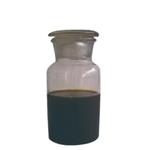The oil cannot be steam-distilled from the balsam because of its very high boiling point; instead it is co-distilled from
the resin in approximately 43 to 55% yields, using volatile solvents. The oil has a warm, sweet, balsamic, lasting odor and bitter taste.
Peru balsam consists of the bark exudate obtained from large trees (up to 15 m or 49 ft high) growing in a rather limited
area of Central America (El Salvador). The name Peruvian balsam therefore is a misnomer. The balsam is collected by two methods:
(1) By partially burning the bark, which permits its easy removal after a few days. The bark fragments then are immersed in hot,
boiling water and the oozed balsam is collected at the bottom of the containers. (2) By wrapping a cloth around incisions made in
the bark. The cloth, impregnated with balsam, is then boiled to separate the product. Finally, the residual water is removed from the
balsam by direct heating. The balsam is an oleoresin containing 25 to 30% resinous material and 60 to 65% essential oil. Peru balsam
has a sweet, delicate, lasting odor reminiscent of vanilla and a bitter taste. The part used is the balsam (oleoresin).
Peru balsam oil is obtained by distillation of the balsam of the tree Myroxylon
balsamum var. pereirae (Royle) Harms (Fabaceae), called Peru balsam. It is a yellow
to pale brown, slightly viscous liquid, which may form crystals.The oil has a
rather sweet, balsamic odor.
d2525 1.095–1.110; n20D 1.5670–1.5790; α20D ?1 ° to +2 °; acid number: 30–60; ester
number: 200–225; solubility: 1 vol in at least 0.5 vol of 90% ethanol.
Peru balsam is produced almost exclusively in El Salvador in a quantity of about
100 t/yr. The oil yield from the balsam is about 50%. Major components
are benzyl benzoate and benzyl cinnamate. Nerolidol and vanillin contribute to the odor.
The oil is used for its excellent fixative properties in perfumes for soap and cosmetics.
Use of Peru balsam is banned because it is allergenic.
Peru balsam is a viscous, transparent, dark-brown mass. The balsam is readily soluble in 95%
alcohol, chloroform and glacial acetic acid, and only partially soluble in ether and petroleum ether.
The oil is a pale-brown, slightly viscous liquid. Occasionally crystals may separate from the
liquid. The oil is soluble in most fixed oils and mineral oil (with turbidity). It is practically insoluble in glycerin and partly soluble in
propylene glycol.
Peru balsam is the exudation from the trunk of Myroxylon pereirae (Royle) Klotzsche (Fam. Leguminosae) (Guenther, 1952)
flavor in tobacco, drinks, pastries, cakes, wines, liquors, spices etc.; fixative and fragrance in perfumery; used to harden soap;
some perfumery uses (fixer; powder; vanilla; prune; coconut); in topieal medicaments, dentistry, etc.
Balsam Peru Oil is a flavoring agent, which is liquid, and yellow to pale green in color. It is viscous and has a sweet balsamic odor. It is insoluble in glycerin, slightly soluble in propylene glycol, soluble and turbid in mineral oil, and soluble in fixed oils. It is obtained by extraction or distillation of peruvian balsam obtained from myroxylon pereirae royal klotsche of the leguminosae family. It can be used alone or in combination with other flavoring substances or adjuvants.
balsam Peru (Myroxylon pereirae) is a botanical attributed with strong medicinal actions. It is considered anti-bacterial, antifungal, and anti-parasitic, and is preferred by some to sulfur ointments. It is recommended for cases of scabies and skin problems such as acne and eczema. Balsam Peru can also be employed in a cosmetic to mask odor, lending a vanilla and cinnamon-like scent to a preparation. Its main constituents are a colorless, aromatic, oily liquid called cinnamein; a dark resin known as peruviol; a small quantity of vanillin; and cinnamic acid. It is extracted from the trunk of a large and beautiful tree, akin to mahogany. every part of the tree, including the leaves, abounds in a resinous juice. It may cause skin irritation.
Peru balsam is used as a mounting medium for microscope specimens.
Extractives and their physically modified derivatives. It consists primarily of resins, essential oils, and usually cinnamic and benzoic acids. (Myroxylon balsamum pereirae, Leguminosae).
By collection of the exudation from the trunk of Myroxylon pereirae (Arctander, 1960).
Essential oil composition
The main constituents include benzyl benzoate, benzyl cinnamate, n-nerolidol, farnesol, vanillin, cinnamyl
alcohol, cinnamyl cinnamate and probably stilbene.
A mild allergen.
Combustible when heated. When heated to
decomposition it emits acrid smoke and
irritating fumes.


